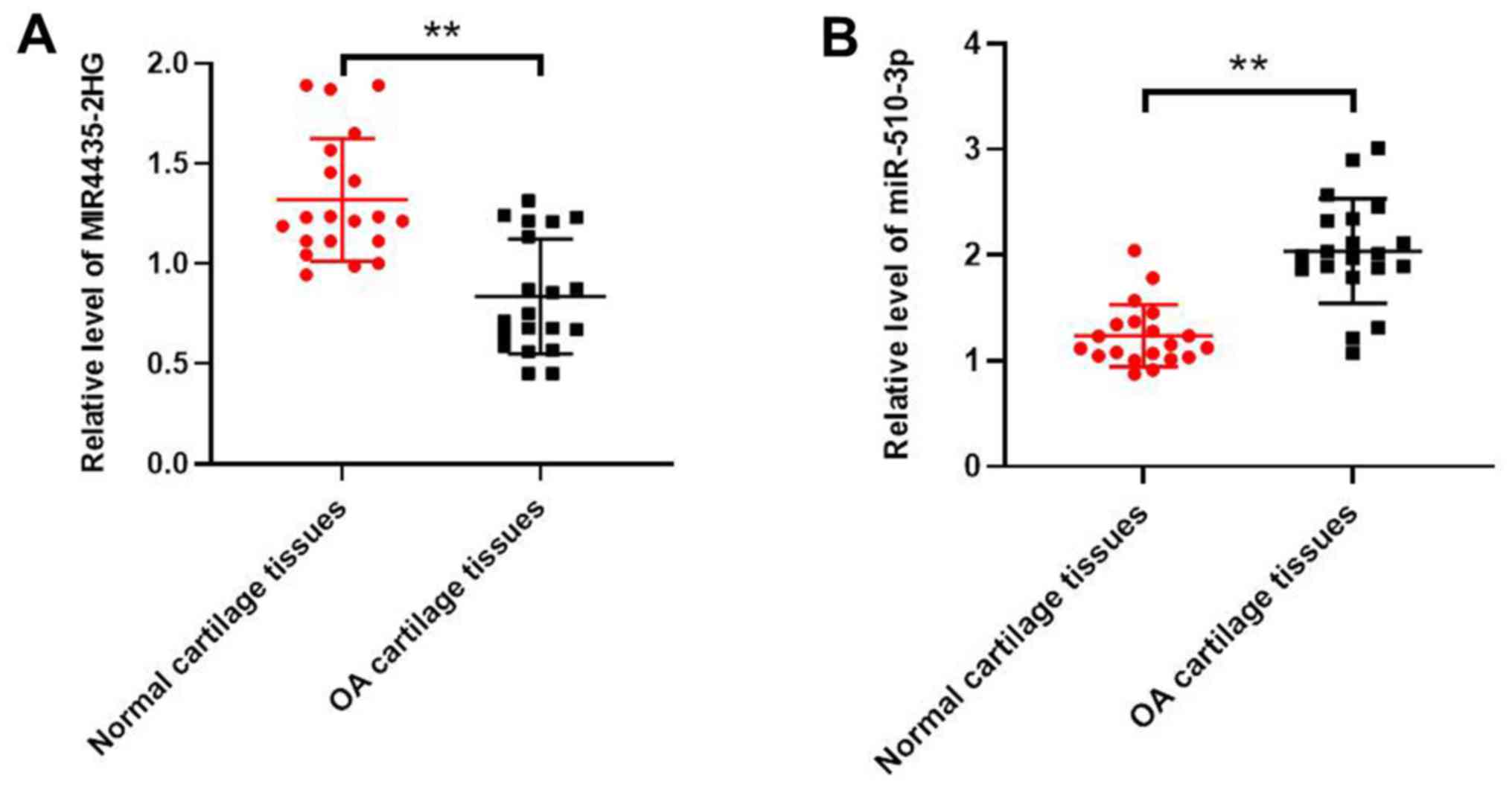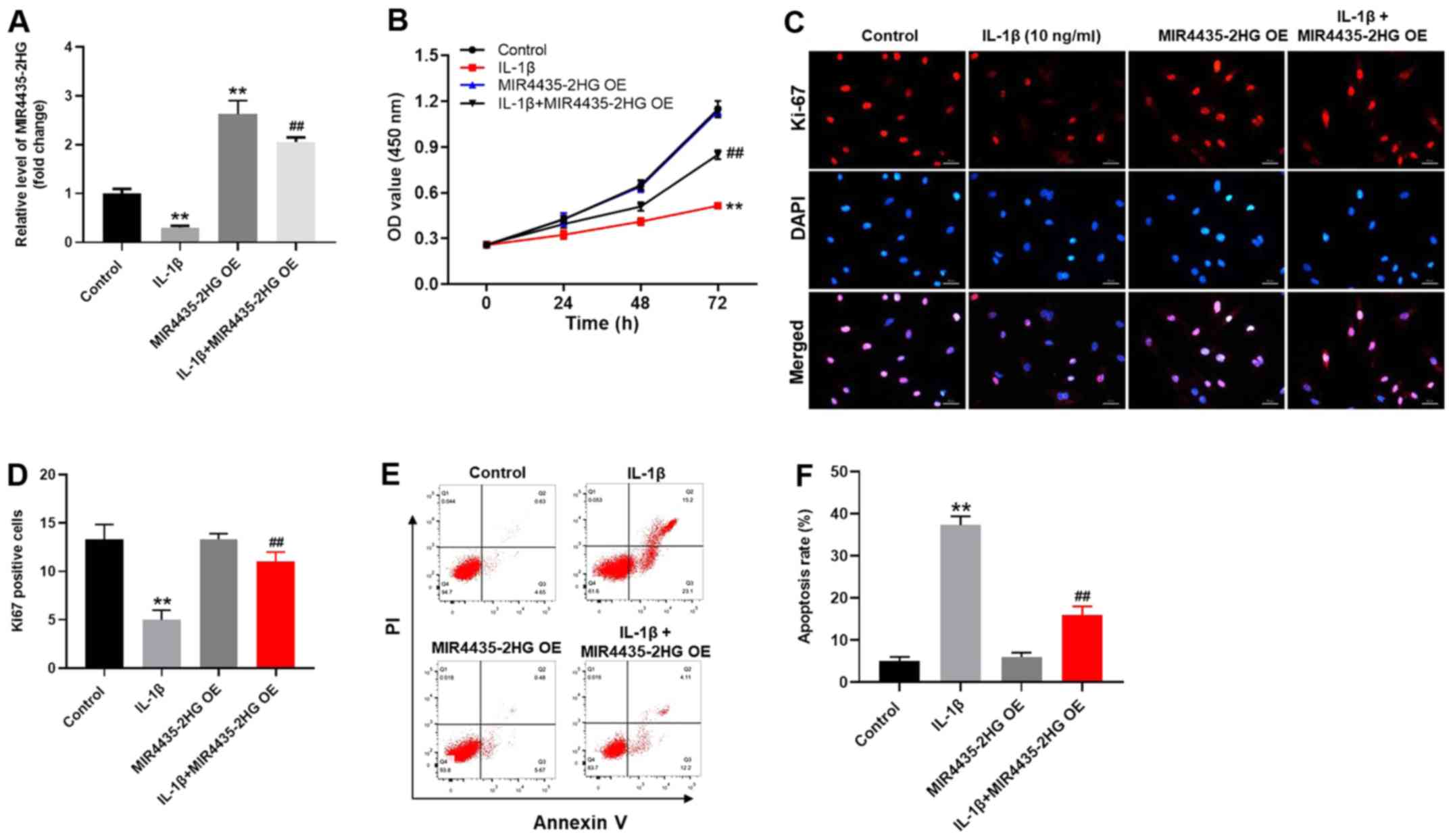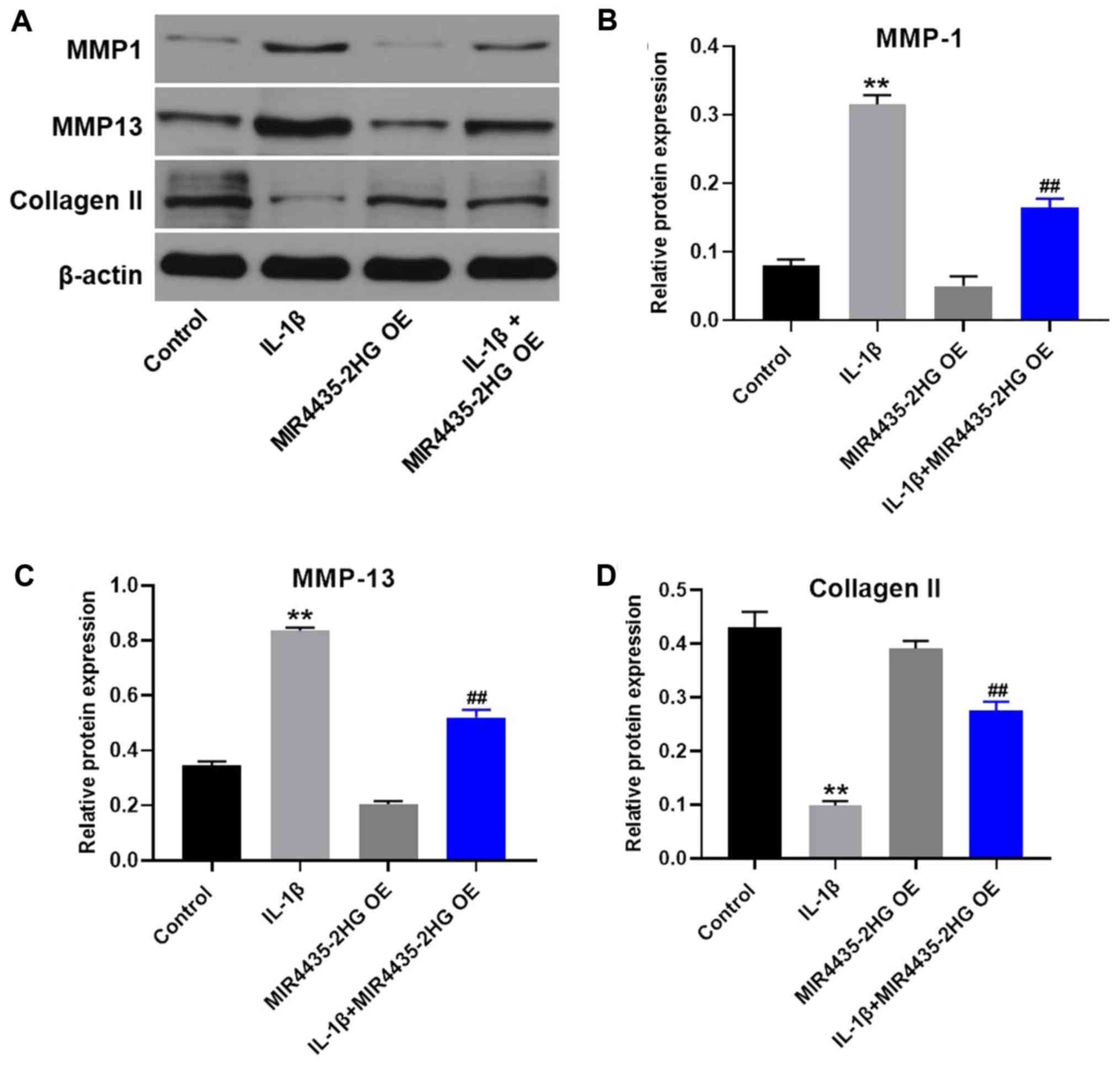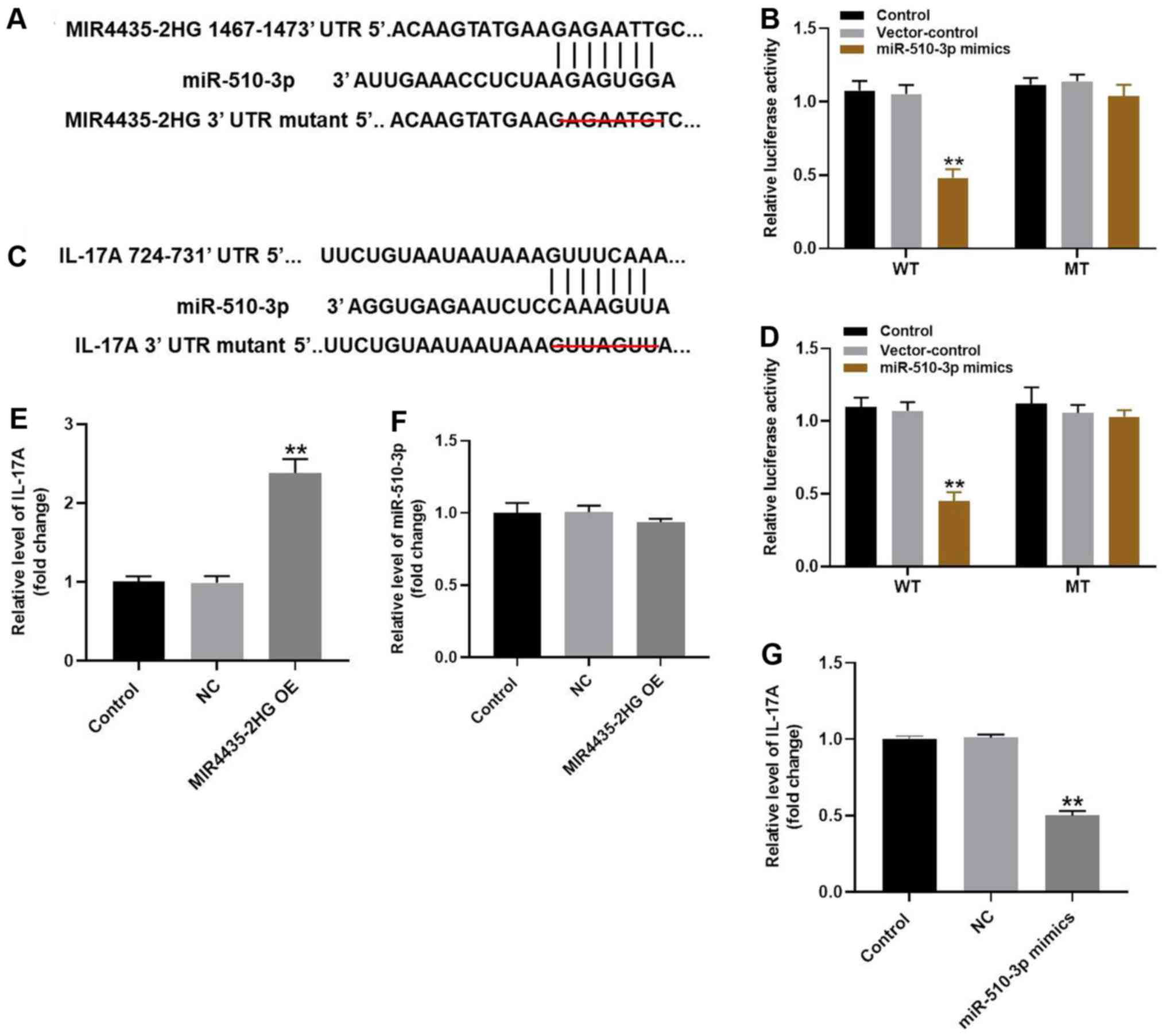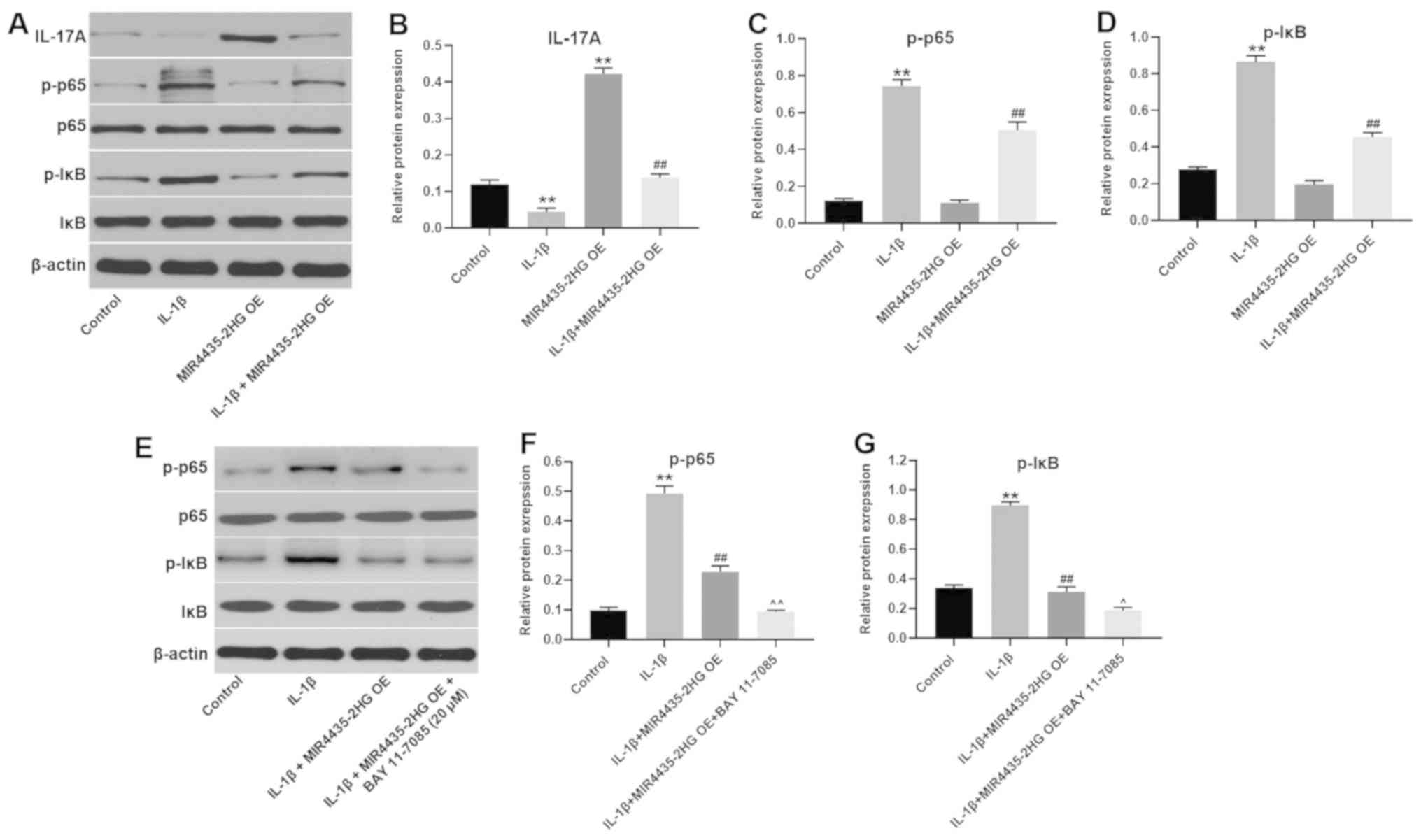|
1
|
Thompson RL, Gardner JK, Zhang S and
Reinbolt JA: Lower-limb joint reaction forces and moments during
modified cycling in healthy controls and individuals with knee
osteoarthritis. Clin Biomech (Bristol, Avon). 71:167–175.
2020.PubMed/NCBI View Article : Google Scholar
|
|
2
|
Brandt KD: Osteoarthritis. Clin Geriatr
Med. 4:279–293. 1988.PubMed/NCBI
|
|
3
|
Mehl J, Imhoff AB and Beitzel K:
Osteoarthritis of the shoulder: Pathogenesis, diagnostics and
conservative treatment options. Orthopade. 47:368–376.
2018.PubMed/NCBI View Article : Google Scholar : (In German).
|
|
4
|
Lukusa A, Malemba JJ, Lebughe P, Akilimali
P and Mbuyi-Muamba JM: Clinical and radiological features of knee
osteoarthritis in patients attending the university hospital of
Kinshasa, Democratic Republic of Congo. Pan Afr Med J.
34(29)2019.PubMed/NCBI View Article : Google Scholar
|
|
5
|
Andreasson I, Kjellby-Wendt G,
Fagevik-Olsén M, Aurell Y, Ullman M and Karlsson J: Long-term
outcomes of corrective osteotomy for malunited fractures of the
distal radius. J Plast Surg Hand Surg. 54:94–100. 2020.PubMed/NCBI View Article : Google Scholar
|
|
6
|
Nehrer S, Ljuhar R, Steindl P, Simon R,
Maurer D, Ljuhar D, Bertalan Z, Dima HP, Goetz C and Paixao T:
Automated knee osteoarthritis assessment increases physicians'
agreement rate and accuracy: Data from the osteoarthritis
initiative. Cartilage: Nov 24, 2019 (Epub ahead of print).
|
|
7
|
Gerbrands TA, Pisters MF and Vanwanseele
B: Individual selection of gait retraining strategies is essential
to optimally reduce medial knee load during gait. Clin Biom
(Bristol, Avon). 29:828–834. 2014.PubMed/NCBI View Article : Google Scholar
|
|
8
|
Hochberg-Laufer H, Neufeld N, Brody Y,
Nadav-Eliyahu S, Ben-Yishay R and Shav-Tal Y: Availability of
splicing factors in the nucleoplasm can regulate the release of
mRNA from the gene after transcription. PLoS Genet.
15(e1008459)2019.PubMed/NCBI View Article : Google Scholar
|
|
9
|
Qi Y, Ma Y, Peng Z, Wang L, Li L, Tang Y,
He J and Zheng J: Long noncoding RNA PENG upregulates PDZK1
expression by sponging miR-15b to suppress clear cell renal cell
carcinoma cell proliferation. Oncogene: Apr 27, 2020 (Epub ahead of
print).
|
|
10
|
Soares JC, Soares AC, Rodrigues VC,
Melendez ME, Santos AC, Faria EF, Reis RM, Carvalho AL and Oliveira
ON Jr: Detection of the prostate cancer biomarker PCA3 with
electrochemical and impedance-based biosensors. ACS Appl Mater
Interfaces. 11:46645–46650. 2019.PubMed/NCBI View Article : Google Scholar
|
|
11
|
Tu C, Ren X, He J, Zhang C, Chen R, Wang W
and Li Z: The Value of LncRNA BCAR4 as a prognostic biomarker on
clinical outcomes in human cancers. J Cancer. 10:5992–6002.
2019.PubMed/NCBI View Article : Google Scholar
|
|
12
|
Jiang Z, Li L, Hou Z, Liu W, Wang H, Zhou
T, Li Y and Chen S: LncRNA HAND2-AS1 inhibits 5-fluorouracil
resistance by modulating miR-20a/PDCD4 axis in colorectal cancer.
Cell Signal. 66(109483)2020.PubMed/NCBI View Article : Google Scholar
|
|
13
|
Li Y, Li S, Luo Y, Liu Y and Yu N: LncRNA
PVT1 regulates chondrocyte apoptosis in osteoarthritis by acting as
a sponge for miR-488-3p. DNA Cell Biol. 36:571–580. 2017.PubMed/NCBI View Article : Google Scholar
|
|
14
|
Xiao Y, Bao Y, Tang L and Wang L: LncRNA
MIR4435-2HG is downregulated in osteoarthritis and regulates
chondrocyte cell proliferation and apoptosis. J Orthop Surg Res.
14(247)2019.PubMed/NCBI View Article : Google Scholar
|
|
15
|
Kloppenburg M, Kroon FP, Blanco FJ,
Doherty M, Dziedzic KS, Greibrokk E, Haugen IK, Herrero-Beaumont G,
Jonsson H, Kjeken I, et al: 2018 update of the EULAR
recommendations for the management of hand osteoarthritis. Ann
Rheumatic Dis. 78:16–24. 2019.PubMed/NCBI View Article : Google Scholar
|
|
16
|
Wang X, Fan J, Ding X, Sun Y, Cui Z and
Liu W: Tanshinone I inhibits IL-1β-induced apoptosis, inflammation
and extracellular matrix degradation in chondrocytes CHON-001 cells
and attenuates murine osteoarthritis. Drug Des Devel Ther.
13:3559–3568. 2019.PubMed/NCBI View Article : Google Scholar
|
|
17
|
Lin Q and Di YP: Determination and
quantification of bacterial virulent gene expression using
quantitative real-time PCR. Methods Mol Biol. 2102:177–193.
2020.PubMed/NCBI View Article : Google Scholar
|
|
18
|
McAlinden A and Im GI: MicroRNAs in
orthopaedic research: Disease associations, potential therapeutic
applications, and perspectives. J Orthop Res. 36:33–51.
2018.PubMed/NCBI View Article : Google Scholar
|
|
19
|
Lu F, Liu P, Zhang Q, Wang W and Guo W:
Association between the polymorphism of IL-17A and IL-17F gene with
knee osteoarthritis risk: A meta-analysis based on case-control
studies. J Orthop Surg Res. 14(445)2019.PubMed/NCBI View Article : Google Scholar
|
|
20
|
Kaul NC, Mohapatra SR, Adam I, Tucher C,
Tretter T, Opitz CA, Lorenz HM and Tykocinski LO: Hypoxia decreases
the T helper cell-suppressive capacity of synovial fibroblasts by
downregulating IDO1-mediated tryptophan metabolism. Rheumatology.
59:1148–1158. 2020.PubMed/NCBI View Article : Google Scholar
|
|
21
|
Lin S, Zhang R, An X, Li Z, Fang C, Pan B,
Chen W, Xu G and Han W: LncRNA HOXA-AS3 confers cisplatin
resistance by interacting with HOXA3 in non-small-cell lung
carcinoma cells. Oncogenesis. 8(60)2019.PubMed/NCBI View Article : Google Scholar
|
|
22
|
Nanus DE, Wijesinghe SN, Pearson MJ,
Hadjicharalambous MR, Rosser A, Davis ET, Lindsay MA and Jones SW:
Obese osteoarthritis patients exhibit an inflammatory synovial
fibroblast phenotype, which is regulated by the long non coding RNA
MALAT1. Arthritis Rheumatol. 72:1–29. 2019.
|
|
23
|
Mao T, He C, Wu H, Yang B and Li X:
Silencing lncRNA HOTAIR declines synovial inflammation and
synoviocyte proliferation and promotes synoviocyte apoptosis in
osteoarthritis rats by inhibiting Wnt/β-catenin signaling pathway.
Cell Cycle. 18:3189–3205. 2019.PubMed/NCBI View Article : Google Scholar
|
|
24
|
Tan C, Zhang J, Chen W, Feng F, Yu C, Lu
X, Lin R, Li Z, Huang Y, Zheng L, et al: Inflammatory cytokines via
up-regulation of aquaporins deteriorated the pathogenesis of early
osteoarthritis. PLoS One. 14(e0220846)2019.PubMed/NCBI View Article : Google Scholar
|
|
25
|
Kapoor M, Martel-Pelletier J, Lajeunesse
D, Pelletier JP and Fahmi H: Role of proinflammatory cytokines in
the pathophysiology of osteoarthritis. Nat Rev Rheumatol. 7:33–42.
2011.PubMed/NCBI View Article : Google Scholar
|
|
26
|
Zhang Y, Liu S, Guo W, Hao C, Wang M, Li
X, Zhang X, Chen M, Wang Z, Sui X, et al: Coculture of hWJMSCs and
pACs in oriented scaffold enhances hyaline cartilage regeneration
in vitro. Stem Cells Int. 2019(5130152)2019.PubMed/NCBI View Article : Google Scholar
|
|
27
|
Wang M, Sampson ER, Jin H, Li J, Ke QH, Im
HJ and Chen D: MMP13 is a critical target gene during the
progression of osteoarthritis. Arthritis Res Ther.
15(R5)2013.PubMed/NCBI View
Article : Google Scholar
|
|
28
|
Ji B, Ma Y, Wang H, Fang X and Shi P:
Activation of the P38/CREB/MMP13 axis is associated with
osteoarthritis. Drug Des Devel Ther. 13:2195–2204. 2019.PubMed/NCBI View Article : Google Scholar
|
|
29
|
Zheng W, Feng Z, Lou Y, Chen C, Zhang C,
Tao Z, Li H, Cheng L and Ying X: Silibinin protects against
osteoarthritis through inhibiting the inflammatory response and
cartilage matrix degradation in vitro and in vivo. Oncotarget.
8:99649–99665. 2017.PubMed/NCBI View Article : Google Scholar
|
|
30
|
Lorenz J, Seebach E, Hackmayer G, Greth C,
Bauer RJ, Kleinschmidt K, Bettenworth D, Böhm M, Grifka J and
Grässel S: Melanocortin 1 receptor-signaling deficiency results in
an articular cartilage phenotype and accelerates pathogenesis of
surgically induced murine osteoarthritis. PLoS One.
9(e105858)2014.PubMed/NCBI View Article : Google Scholar
|
|
31
|
Lin SL and Ying SY: Mechanism and method
for generating tumor-free ips cells using intronic microRNA miR-302
induction. Methods Mol Biol. 1733:265–282. 2018.PubMed/NCBI View Article : Google Scholar
|
|
32
|
Eguchi T and Kuboki T: Cellular
reprogramming using defined factors and microRNAs. Stem Cells Int.
2016(7530942)2016.PubMed/NCBI View Article : Google Scholar
|
|
33
|
Pourrajab F, Vakili Zarch A,
Hekmatimoghaddam S and Zare-Khormizi MR: The master switchers in
the aging of cardiovascular system, reverse senescence by microRNA
signatures; as highly conserved molecules. Prog Biophys Mol Biol.
119:111–128. 2015.PubMed/NCBI View Article : Google Scholar
|
|
34
|
Lei J, Fu Y, Zhuang Y, Zhang K and Lu D:
LncRNA SNHG1 alleviates IL-1beta-induced osteoarthritis by
inhibiting miR-16-5p-mediated p38 MAPK and NF-kappaB signaling
pathways. Bioscience reports 39, 2019.
|
|
35
|
Zhang Y, Wang F, Chen G, He R and Yang L:
LncRNA MALAT1 promotes osteoarthritis by modulating miR-150-5p/AKT3
axis. Cell Biosci. 9(54)2019.PubMed/NCBI View Article : Google Scholar
|
|
36
|
Gao H, Peng L, Li C, Ji Q and Li P:
Salidroside alleviates cartilage degeneration through NF-κB pathway
in osteoarthritis rats. Drug Des Devel Ther. 14:1445–1454.
2020.PubMed/NCBI View Article : Google Scholar
|
|
37
|
Xu C, Sheng S, Dou H, Chen J, Zhou K, Lin
Y and Yang H: α-Bisabolol suppresses the inflammatory response and
ECM catabolism in advanced glycation end products-treated
chondrocytes and attenuates murine osteoarthritis. Int
Immunopharmacol: Apr 22, 2020 (Epub ahead of print).
|
|
38
|
Adlakha YK and Saini N: Brain microRNAs
and insights into biological functions and therapeutic potential of
brain enriched miRNA-128. Mol Cancer. 13(33)2014.PubMed/NCBI View Article : Google Scholar
|
|
39
|
Plé H, Landry P, Benham A, Coarfa C,
Gunaratne PH and Provost P: The repertoire and features of human
platelet microRNAs. PLoS One. 7(e50746)2012.PubMed/NCBI View Article : Google Scholar
|
|
40
|
Wang J, Wang X, Wang L, Sun C, Xie C and
Li Z: MiR-let-7d-3p regulates IL-17 expression through targeting
AKT1/mTOR signaling in CD4(+) T cells. In vitro Cell Dev Biol
Animal. 56:67–74. 2020.PubMed/NCBI View Article : Google Scholar
|
|
41
|
Zhou X, Chen H, Wei F, Zhao Q, Su Q, Lei
Y, Yin M, Tian X, Liu Z, Yu B, et al: α-mangostin attenuates
pristane-induced lupus nephritis by regulating Th17
differentiation. Int J Rheum Dis. 23:74–83. 2020.PubMed/NCBI View Article : Google Scholar
|
|
42
|
Me R, Gao N, Dai C and Yu FX: IL-17
Promotes pseudomonas aeruginosa keratitis in C57BL/6 mouse corneas.
J Immunol. 204:169–179. 2020.PubMed/NCBI View Article : Google Scholar
|
|
43
|
Zhang X, Yuan Y, Pan Z, Ma Y, Wu M, Yang
J, Han R, Chen M, Hu X, Liu R, et al: Elevated circulating IL-17
level is associated with inflammatory arthritis and disease
activity: A meta-analysis. Clin Chim Acta. 496:76–83.
2019.PubMed/NCBI View Article : Google Scholar
|
|
44
|
Ghosh S, May MJ and Kopp EB: NF-kappa B
and Rel proteins: Evolutionarily conserved mediators of immune
responses. Ann Rev Immunol. 16:225–260. 1998.PubMed/NCBI View Article : Google Scholar
|
|
45
|
Puri RV, Yerrathota S, Home T, Idowu JY,
Chakravarthi VP, Ward CJ, Singhal PC, Vanden Heuvel GB, Fields TA
and Sharma M: Notch4 activation aggravates NF-κB mediated
inflammation in HIV-1 associated Nephropathy. Dis Mod Mech. 12:
pii(dmm040642)2019.PubMed/NCBI View Article : Google Scholar
|
|
46
|
Baldwin AS Jr: The NF-kappa B and I kappa
B proteins: New discoveries and insights. Ann Rev Immunol.
14:649–683. 1996.PubMed/NCBI View Article : Google Scholar
|
|
47
|
Schütze S, Wiegmann K, Machleidt T and
Krönke M: TNF-induced activation of NF-kappa B. Immunobiology.
193:193–203. 1995.PubMed/NCBI View Article : Google Scholar
|
|
48
|
TH Lv MM, An XM, Leung WK and Seto WK:
Activation of adenosine A3 receptor inhibits inflammatory cytokine
production in colonic mucosa of patients with ulcerative colitis by
down-regulating the NF-kappaB signaling. J Dig Dis. 21:38–45.
2020.PubMed/NCBI View Article : Google Scholar
|
|
49
|
Ren H, Wang Z, Zhang S, Ma H, Wang Y, Jia
L and Li Y: IL-17A promotes the migration and invasiveness of
colorectal cancer cells through NF-κB-mediated MMP expression.
Oncol Res. 23:249–256. 2016.PubMed/NCBI View Article : Google Scholar
|
|
50
|
Sui C, Zhang L and Hu Y: MicroRNA-let-7a
inhibition inhibits LPS-induced inflammatory injury of chondrocytes
by targeting IL6R. Mol Med Rep. 20:2633–2640. 2019.PubMed/NCBI View Article : Google Scholar
|
|
51
|
Lu W, Ding Z, Liu F, Shan W, Cheng C, Xu
J, He W, Huang W, Ma J and Yin Z: Dopamine delays articular
cartilage degradation in osteoarthritis by negative regulation of
the NF-kappaB and JAK2/STAT3 signaling pathways. Biomed
Pharmacother. 119(109419)2019.PubMed/NCBI View Article : Google Scholar
|















